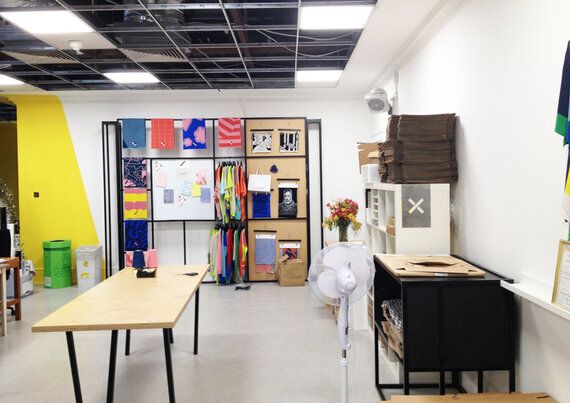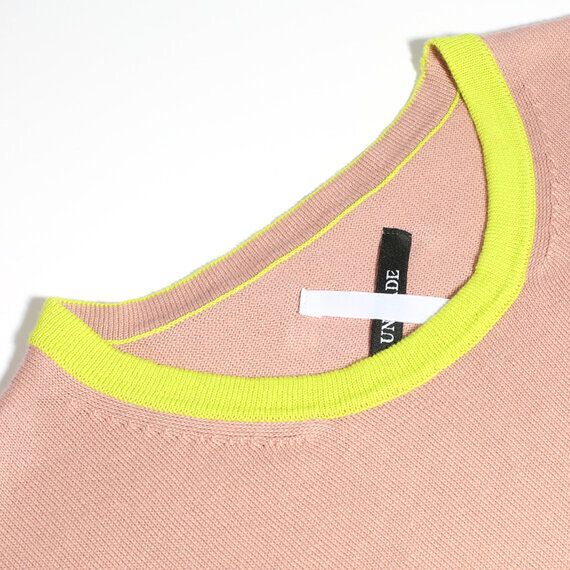
Collaboration. Arguably not the most popular word in a fashion designer's vocabulary. In an industry known for its closed circles and competitive atmosphere, insular working patterns prevail while collaborative habits die hard.
And such practices have landed fashion in a sticky spot.
An unwillingness to modernise an age-old system and continue to churn out collection after collection has caused the planet to suffer, under the weight of too much waste.
Collaboration is the future of the fashion industry
It's time for a change, and collaboration may be the key to a more exciting and sustainable fashion industry.

Unmade studio, Somerset House
Nowhere has this concept been demonstrated more clearly than during my recent visit to the Unmade studio. Itself the result of a collaboration between two engineers and a knitwear designer, the brand is at the forefront of the collaboration revolution, narrowing the gap more than ever between designer and customer.
Not Just Knitwear
While they currently produce only knitwear, their technology is not limited to this field. They have simply pioneered an alternative making process that can, with a few tweaks, be applied to different sectors in turn. They began with knitwear because right now, it is a niche with an open-minded start-up community.
Unmade's proposition? Mass customisation at an accessible price. And at their studio, deep in the underbelly of Somerset House, the needles of change are in motion.

Collar detail, image courtesy of unmade.com
So what does this mean exactly? Well, customisation has gone well beyond the monogram. At unmade.com, you can co-create your own unique jumper, within the parameters set by the designers that Unmade currently collaborate with. It's a kind of curated customisation - integrating rules into the design process, to eliminate the chances of creating a jumper the designer or brand in question would not identify with. For example, while the garment shape remains set, you can customise stripe layout, pattern distribution and chose between set colour ways. You cannot however, chose a colour outside of the set list or change the scale of a particular pattern.
Have a go yourself.
Innovation v tradition
At a time when some of the most prominent designers are struggling with the industry's pace and perpetual desire for newness, collaborating with the customer to create something unique to them presents an interesting alternative. Sustainability, after all, refers to working practices as well as material products.
But the question remains as to whether we enjoy a collaborative role in the creation of our garments or would rather the 'professionals' kept it in hand. While some may find it an exciting prospect, it would be fair to say the latter have mixed views.

Colour combinations, image courtesy of unmade.com
The more heritage a brand has, the more concerned they seem to be. The idea of a customer redesigning the iconic Burberry check, for example, while still retaining the much sought after label, can be a fairly uncomfortable idea to come to terms with.
The studio at Somerset House is an outlet to demonstrate the software's capabilities, not just to the adventurous consumer, but also to the cautious designer.
Because Unmade, ultimately, have a much bigger goal in mind: to collaborate with international brands and manufacturers so that they may offer the service directly to their customers; to be the silent technology behind the scenes, encouraging and enabling fashion to change its methods.
A method of manufacturing that is more sustainable
I believe that if we understand how a garment is made, we are more likely to value it.

Block jumpers, image courtesy of unmade.com
Unmade's Block jumper provides a perfect example. By observing the points at which the colour of the garment changes when you customise it, you can begin to understand how it is knitted and in turn, put together. And in doing so, it is easier to appreciate the skill needed for its manufacture.
If we are involved in its very creation, through collaboration, there is potential to value a garment even more. It is time for the fashion industry to open up.
Kirsty, Ben and Hal, the trio behind the making of Unmade, met as students at the RCA. They bucked the trend by working together when many others, in this competitive industry would have defaulted to working alone. And their collaborative efforts have resulted in the development of a process that may change the face of fashion - for the better.
This post was originally featured on the study 34 blog
This September The Huffington Post UK Style is focusing on all things sustainable, for the second year running. Our thirst for fast fashion is dramatically impacting the environment and the lives of thousands of workers in a negative way. Our aim is to raise awareness of this zeitgeist issue and champion brands and people working to make the fashion industry a more ethical place.
We'll be sharing stories and blogs with the hashtag #SustainableFashion and we'd like you to do the same. If you'd like to use our blogging platform to share your story, email ukblogteam@huffingtonpost.com.
